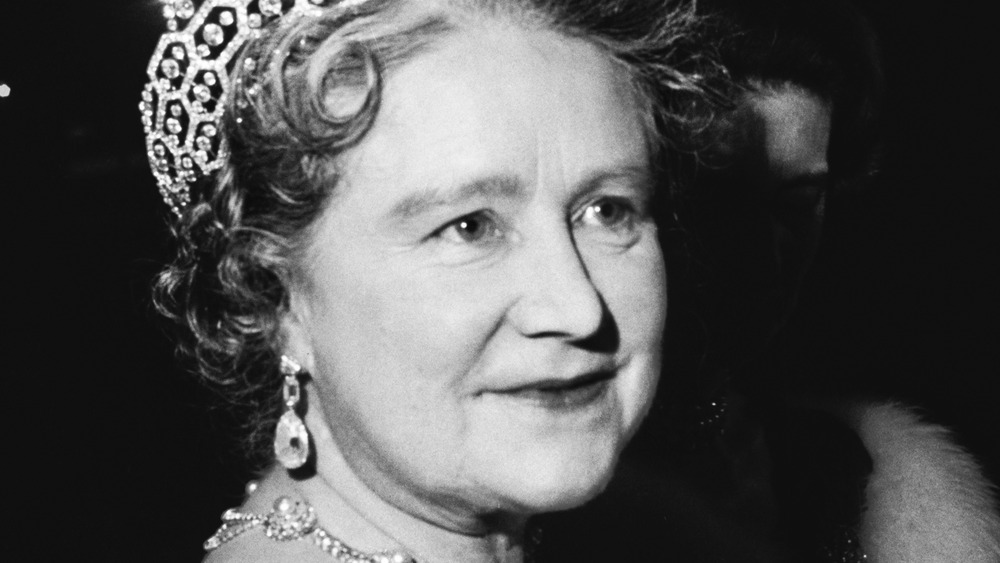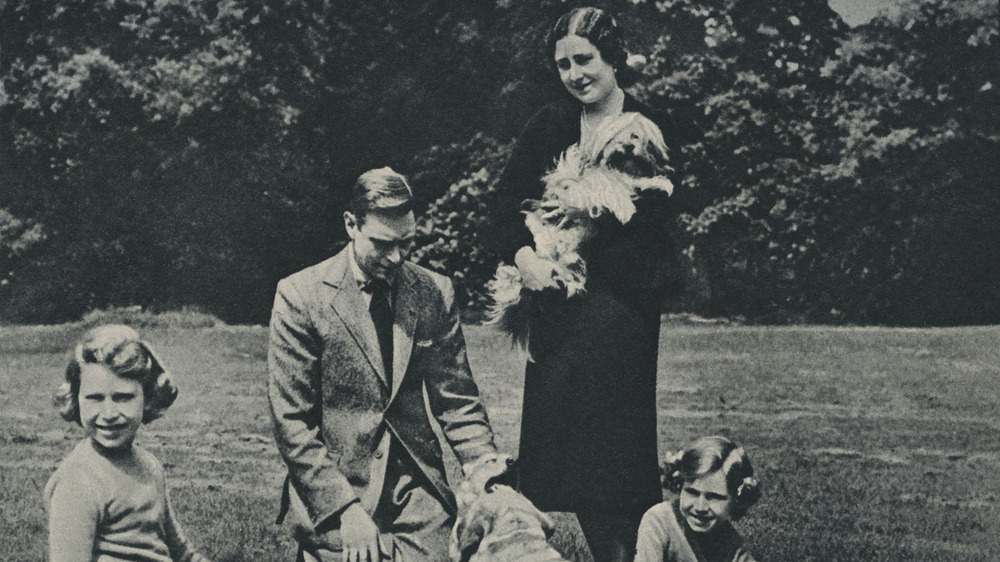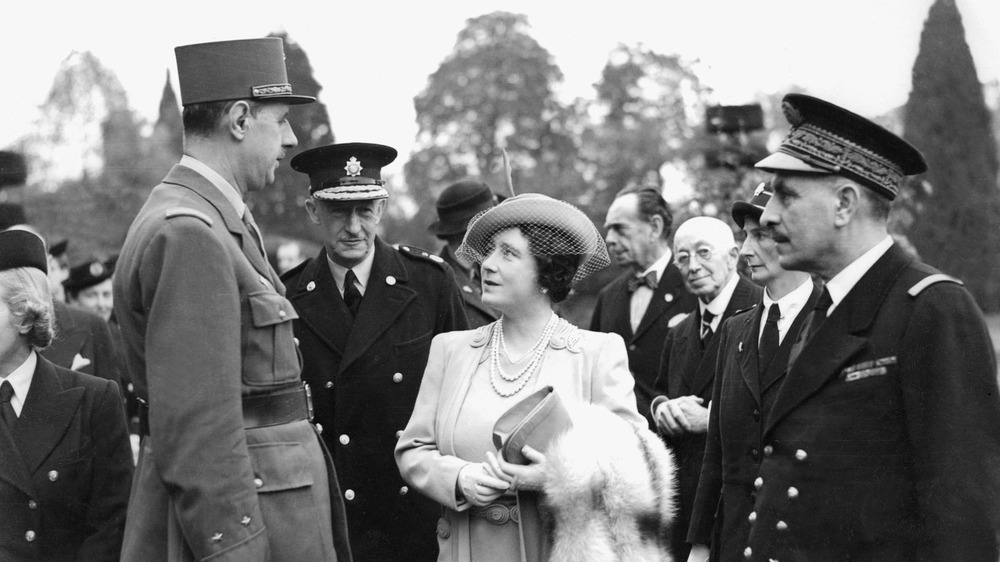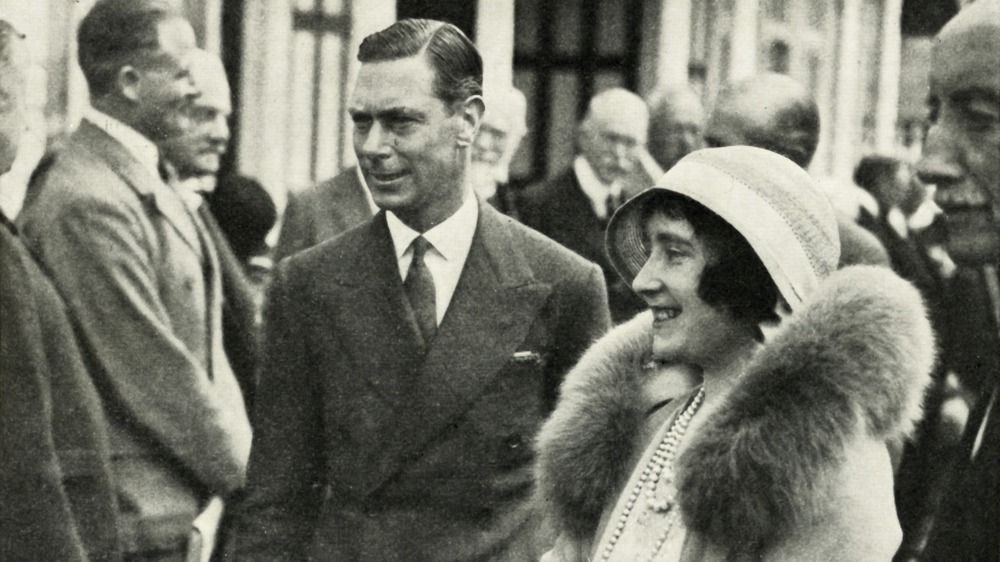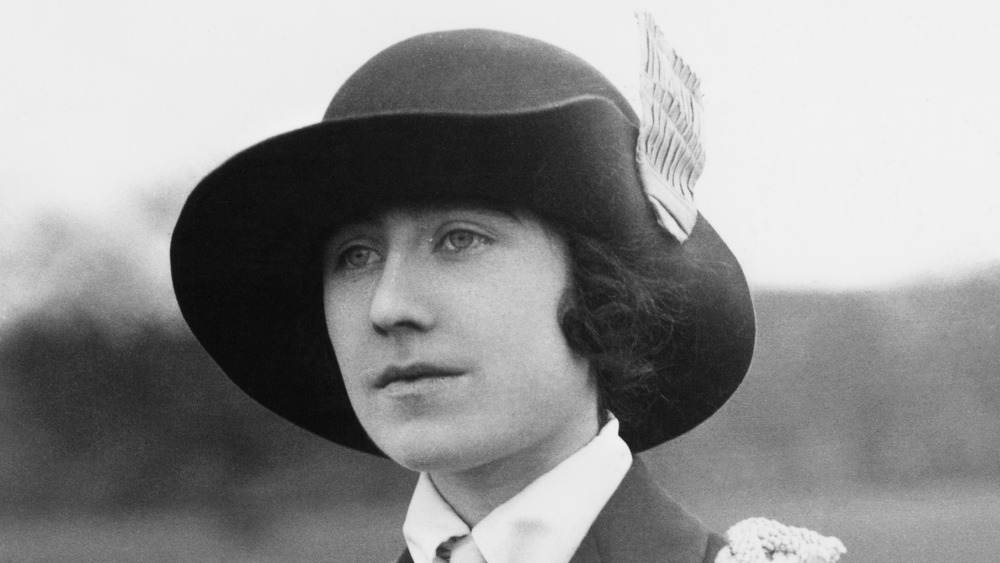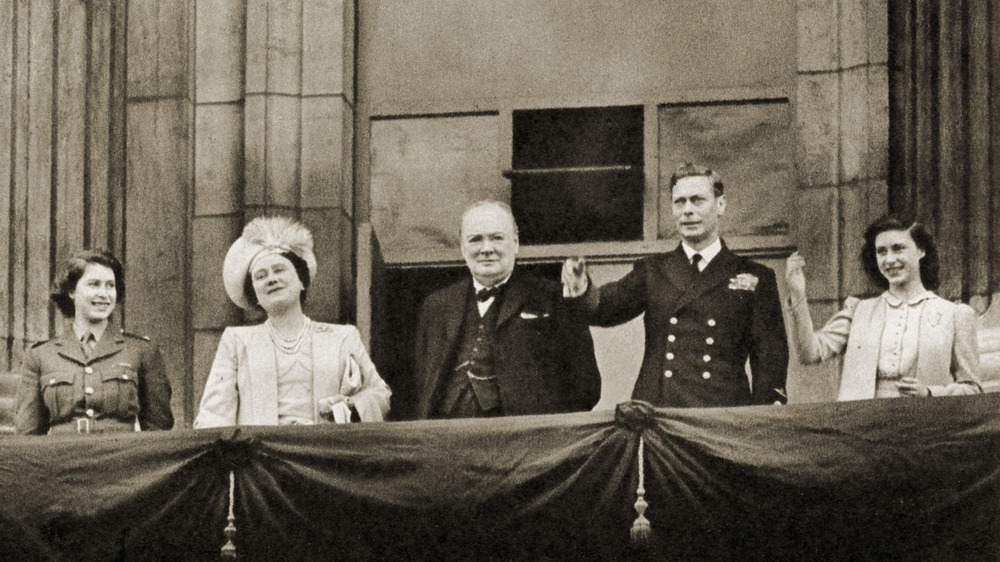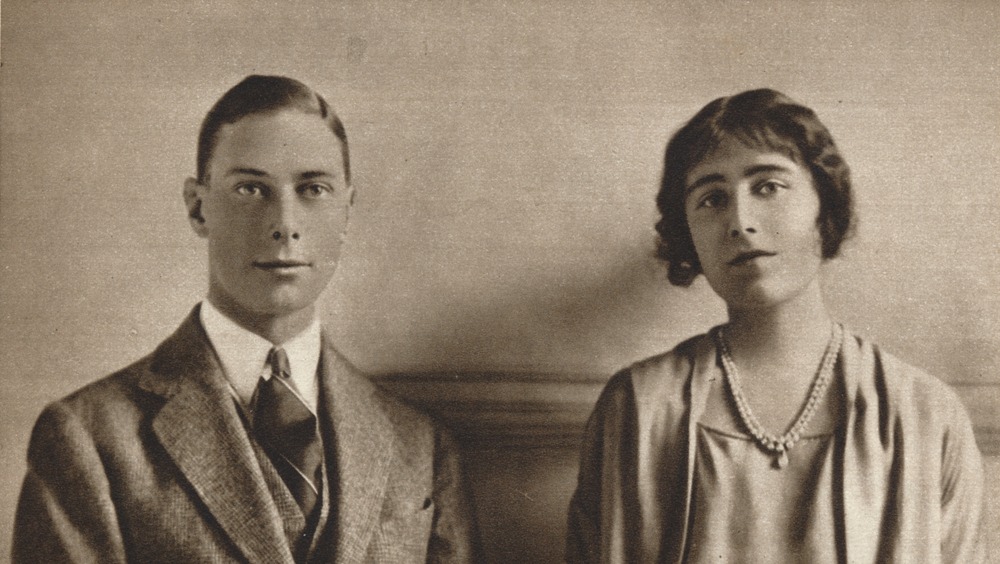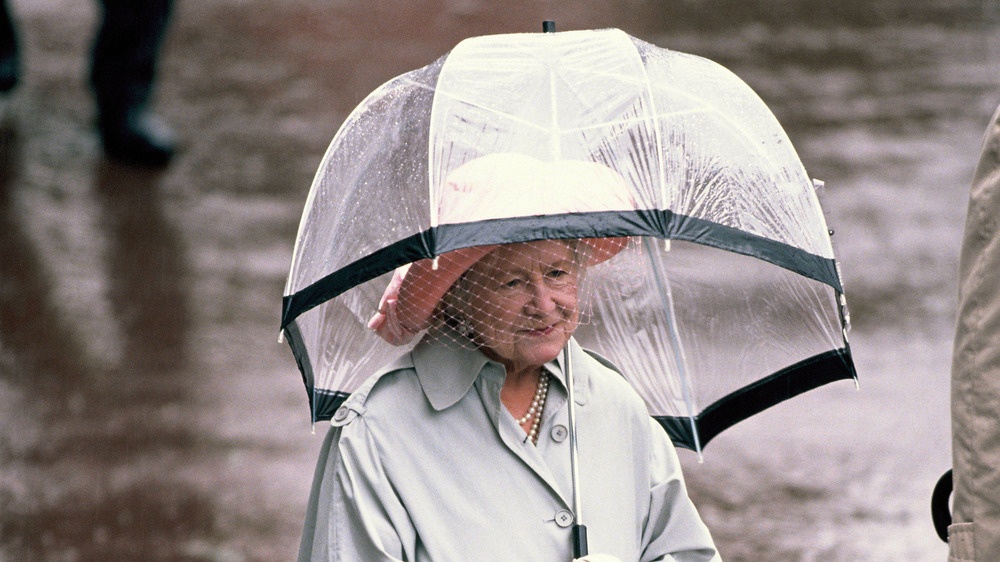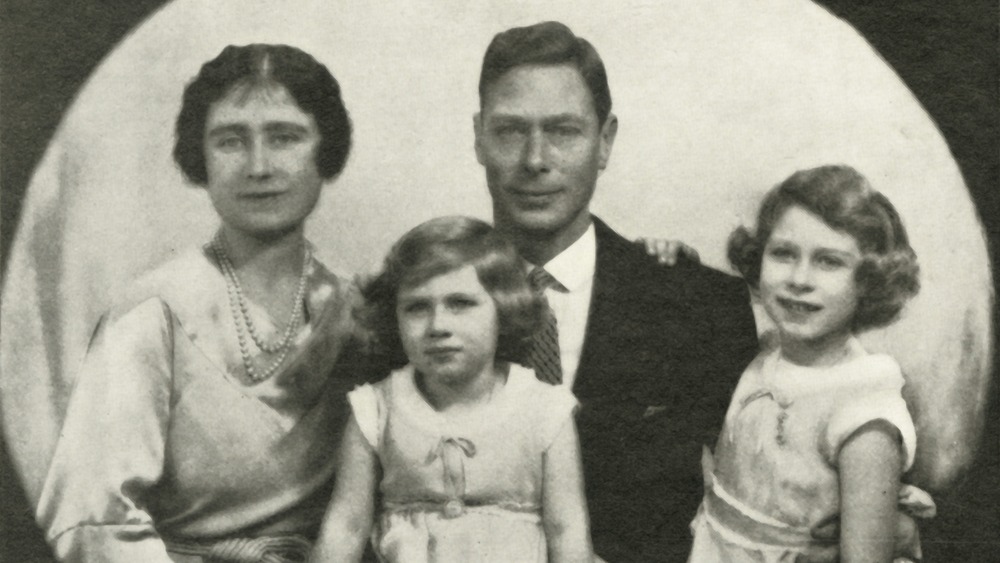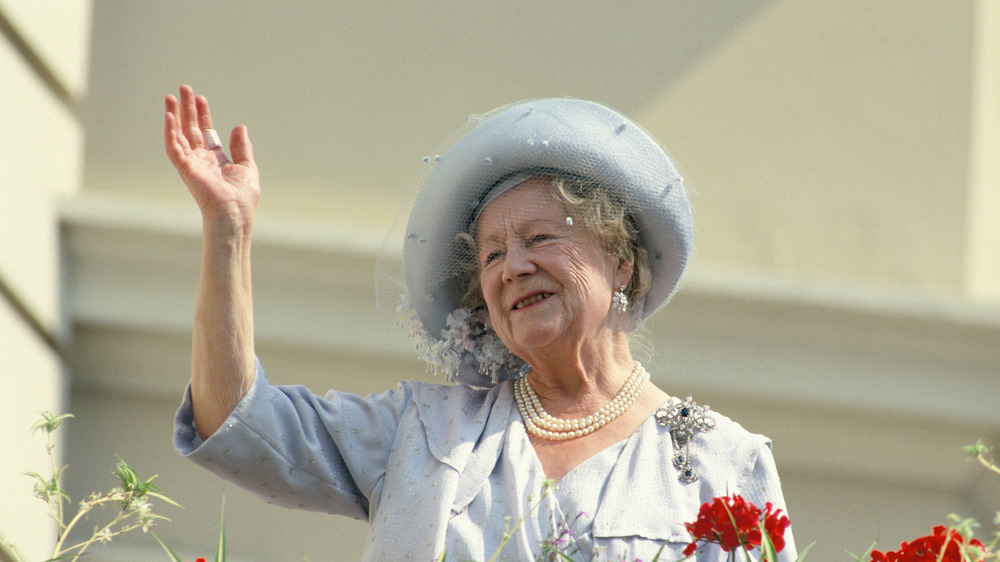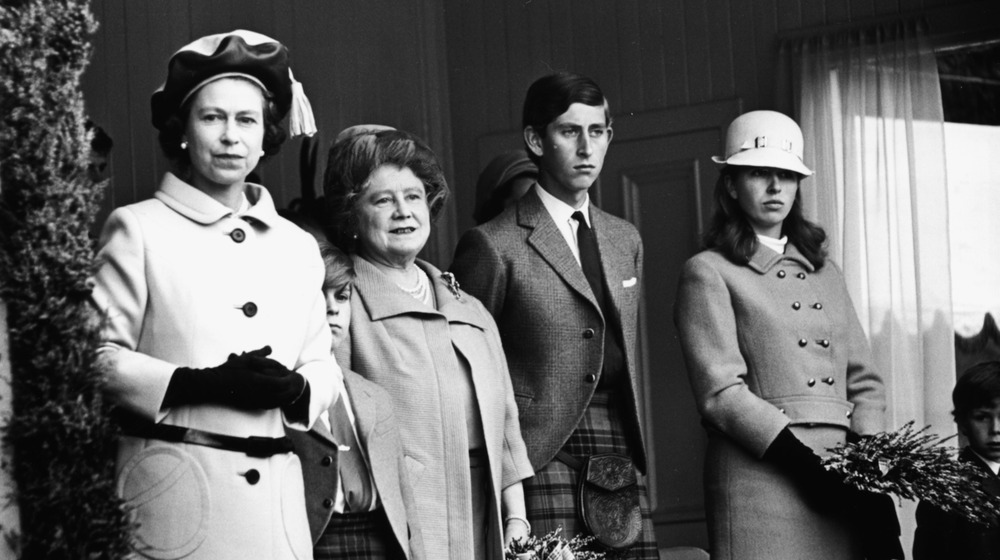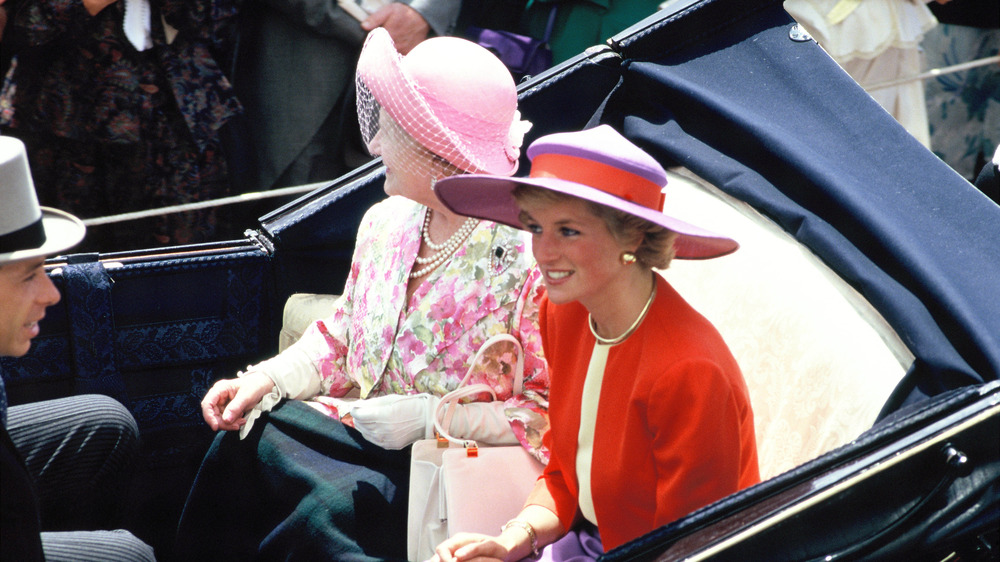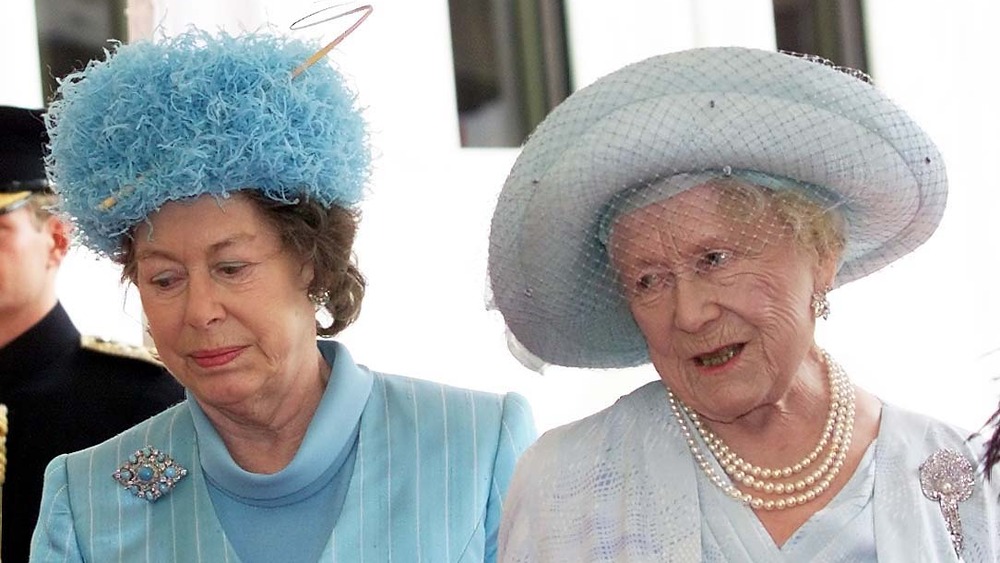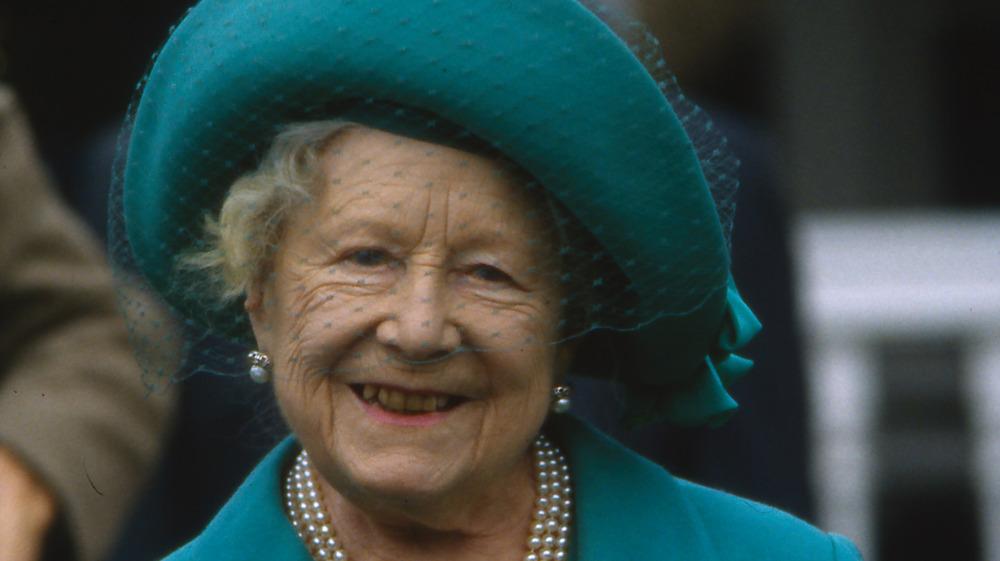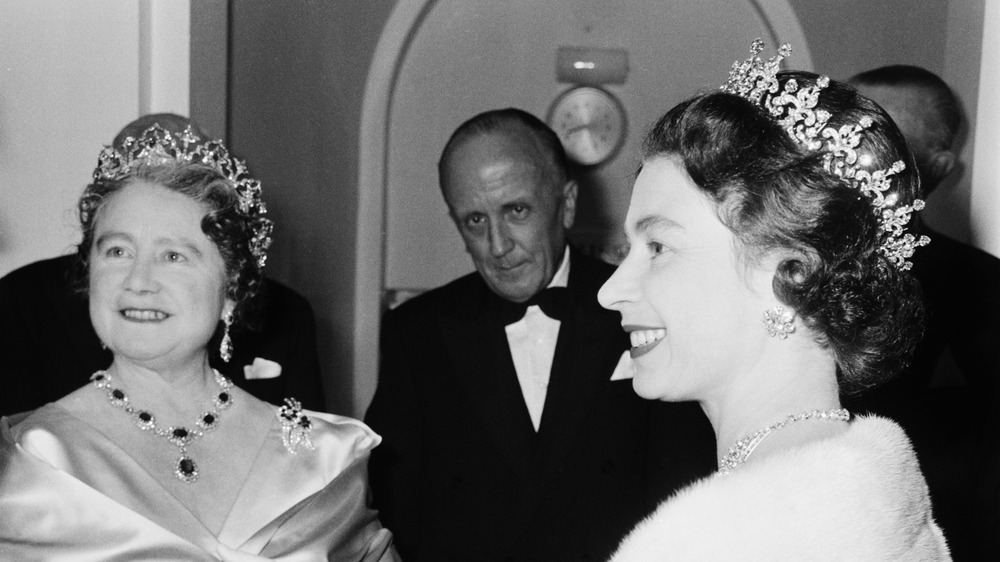The Untold Truth Of The Queen Mother
Even if you're not a fan of the British royal family, you know who Queen Elizabeth is. She has been on the throne for decades and has survived turbulent personal and public dramas while ruling. Elizabeth became queen rather suddenly — the death of her father, King George VI, left the throne vacant and, as such, she became queen. But what happened to the king's wife, Elizabeth, who became known after his death as the Queen Mother?
Yes, both the Queen Elizabeth II and her mother are named Elizabeth, so we'll do our best to differentiate. The Queen Mother married King George when he was Prince Albert, the Duke of York, and not the obvious heir to the British throne. But after his brother, Edward VIII, abdicated the throne so he could marry his lover, Wallis Simpson, Albert became king. He adopted the ruling name of King George VI, his wife became queen, and history cast a dark shadow on Edward.
The Queen Mother lived for 50 years after her husband's death, maintaining her positive public image as the "Queen Mum." Curious about her? Here's the untold truth of the Queen Mother.
The Queen Mother reportedly never forgave Edward VIII for abdicating the throne
King George VI was not first in line to the British throne. His brother, Edward VIII, assumed the throne in 1936, but later abdicated so he could marry his lover — an American who'd already been married and divorced — Wallis Simpson. As noted by Dawn, the Queen Mother — at the time known as Elizabeth, the Duchess of York — became queen when her husband became king in the aftermath of Edward's abdication, and she reportedly never forgave her brother-in-law for the position he had put them in.
So why did Edward have to abdicate? By decree of royal tradition (and the public was not on board, either), he was not allowed to marry Simpson, as she could never become queen due to her divorcee status. As such, he said goodbye to the responsibilities of king and forced them upon his brother. The Queen Mother thought at the time — and seemed to maintain this perspective for life — that her husband was not cut out for the job. She even blamed Edward for her husband's death, as he passed when he was just 56.
"The queen's attitude to [Edward and Wallis] bordered on a vendetta," Ingrid Seward, the Queen Mother's biographer, noted.
The monarch was responsible for boosting national morale during World War II
King George VI took the throne in 1936, and World War II broke out shortly thereafter. Despite the dangers that London was facing — including mass bombings — the Queen Mother and her husband stayed put, and they were responsible for boosting the nation's morale during the circumstances. As noted by Dawn, the Queen Mother became "a focal point for British wartime defiance of the Nazis," and while doing so, casted the royal family in a new light.
The violence and dangers in London got so bad during the war that the king and his family were told to leave, but the Queen Mother didn't budge. "The children will not leave unless I do," she said, as noted by The Irish Times. "I shall not leave unless their father does; and the king will not leave the country in any circumstances." Buckingham Palace was attacked nine times by German bombs, but the Queen Mother used the experience to relate to the realities that people all across the city were facing.
"I'm glad we've been bombed," she said. "It makes me feel I can look the East End in the face."
The Queen Mother had a complicated relationship with her role as a ruler
The role of king was forced on King George VI, so naturally the Queen Mother had a difficult relationship with her role as a royal as well. She was the Duchess of York and was used to royal expectations, but being forced into the spotlight with her husband came at a price. As noted by Express, the Queen Mother believed that Wallis Simpson — Edward VIII's wife — "ruin[ed] their lives." According to historian Lucy Moore, the Queen Mother was so upset over the circumstances that she stopped Simpson from being given an HRH title, even though she was married to Edward. "She [the Queen Mother] hated [Wallis] Simpson, even though she handed her the crown," Tanya Gold, a royal writer, told The Guardian (via Express).
Despite the precarious relationship she had with her role, the Queen Mother maintained that it was her "God-given obligation" to serve the British Commonwealth. She was even quoted as telling her daughter, who would one day become Queen Elizabeth II, that "work, darling, is the rent you pay for life." She called the duty an "intolerable honor," which pretty much sums it up.
The Queen Mother was technically born a commoner
Kate Middleton got a ton of attention when she got engaged to Prince William, partially because she was a "commoner." She didn't come from British nobility and didn't have a title, but rather was a pretty ordinary girl from an (albeit wealthy) ordinary family. But Middleton has not been the only commoner to marry into the British royal family. As noted by The Irish Times, the Queen Mother was technically born a commoner, and while her early life was very lavish, she was not bestowed a title until later in life.
The Queen Mother's full name at birth was Elizabeth Angela Marguerite Bowes-Lyon. She was one of 10 children, the second youngest, and received her first nobility title at 4 years old. Her father, Claude Bowes-Lyon, became the 14th Earl of Strathmore when Elizabeth was in her young childhood years, so she became Lady Elizabeth from there on out. Her family had two properties — one in London and the Glamis Castle, located near Dundee — and she spent her childhood between the two locations. So yes, while she was technically born a commoner, her family had a castle.
She met her husband, Prince Albert, early on in her childhood
Society in England was a very important aspect of life, especially for a young lady. Think Bridgerton but in real life, and when the Queen Mother — then Lady Elizabeth — was launched into society in 1919, she had a number of suitors waiting for her. As noted by The Irish Times, one such suitor was Prince Albert, the Duke of York, who would later become King George VI.
While the two had known each other since they were young children, Lady Elizabeth was "reluctant" to entertain his courtship. She reportedly wanted to maintain her sense of freedom, and did not want to conform to the limitations of royal life. Prince Albert proposed three times before Lady Elizabeth said yes, and when she finally did, the engagement was widely celebrated. "There is not a man in England today that doesn't envy him," wrote politician Henry Channon about the union, pointing to just how many suitors Lady Elizabeth had.
The couple got married a year after in a large ceremony at Westminster Abbey, with over 3,000 people in attendance.
Despite personal struggles, the Queen Mother and King George VI had a very happy marriage
As aforementioned, when King Edward VIII abdicated the throne, he left Prince Albert to accept the responsibilities of the crown. There were a number of reasons why the Queen Mother was hesitant about her husband becoming king, but despite the difficulties they faced, the two had a happy marriage. As noted by The Irish Times, George was a timid and shy man — not the type that you'd imagine being king of a commonwealth with one of the most storied royal families in history.
As a result of his shy personality, King George VI developed a very noticeable stammer. Cue the Queen Mother, because she was ready to help her husband through the challenge. It was all due to the Queen Mother that a speech therapist was employed to help King George VI work through his stammer. She stood by his side during public events, was extremely supportive during all of his duties as king — all in all, she stepped up and took the reins when her husband needed help.
During a royal tour of South Africa, the Queen Mother reportedly hit a man with her parasol
Representing the crown abroad is a big deal, so it was pretty groundbreaking when King George VI took his entire family to South Africa with him for his tour. As noted by the royal website, it was "the first time a monarch had undertaken a tour with his family," but things didn't stay peachy throughout the entire time. The trip happened to take place over Princess Elizabeth's 21st birthday. In a gesture to the princess, the children of Zimbabwe were forced to give up their weekly allowances for the purchasing of a diamond brooch for her, but things went downhill quickly.
"Saddest of all was an earlier incident when a skinny barefoot African ran after the royal car while waving what seemed like a piece of paper," Andrew Morton, author of Elizabeth and Margaret, wrote, as noted by The New York Times. "For his pains the queen mother hit him with her parasol, and then police wrestled him to the ground." Turns out that the man only wanted to gift Princess Elizabeth a 10 shilling note, equivalent to about two dollars.
The Queen Mother became a widow at the young age of 51
The world seems to come to a standstill when a member of the royal family dies, and that was the case when King George VI passed away in 1952. He had experienced health complications in the past, and, as noted by The New York Times, he "died peacefully in his sleep." His daughter Princess Elizabeth was made queen shortly thereafter, and the Queen Mother was quickly forced into a new role: the mother of the monarch. She would go on to live another 50 years without her husband.
As noted by The New York Times at the time of her own passing in 2002, the Queen Mother served in her post as the mother of the monarch for the remainder of her life, and it was the royal role that she fulfilled for the longest period of time. Despite the tragedy that had befallen her personal life, the Queen Mother continued on with the job that she "fulfilled with grace, carrying out a grueling schedule of public engagements well into her 90s and never losing her common touch." She was lovingly referred to as the "Queen Mum" by the public, and she always cared for the people she served.
Throughout her life, the Queen Mother was said to have racked up over $9 million in debt
The royal lifestyle looks envious at times, but when the Queen Mother died at 101 years old, she had racked up more than $9 million in debt. As noted by the Daily Mail, she was the most expensive royal member to maintain since Marie Antoinette, and you won't believe just how lavishly she lived.
The Queen Mother insisted on the finest jewelry, couture clothing, and "vintage champagne." She even had 12 racehorses in her own stable. As such, she left a huge amount of debt for her family to take care of. Queen Elizabeth gave her mother more than $2.5 million a year to maintain her lifestyle, and Prince Charles even contributed to his grandmother's purse.
The Queen Mother had overdrafts that the royal bankers were extremely anxious about, and despite the fact that she was budgeted about $900,000 a year, she apparently spent more than eight times that amount of money. She reportedly had the "haziest notion" as to how much life actually cost.
The Queen Mother was closest to this royal relative
While it may only be common knowledge to those in the United Kingdom, or those who are very big fans of the royals, it's long been rumored that Prince Charles has had a difficult relationship with his mother, Queen Elizabeth. So when the 2017 documentary series The Royal House of Windsor was released and Charles spoke about the "distant" relationship he has with his mother, it added even more fuel to the fire. Of course, it didn't help that Charles was incredibly close to the Queen Mother during her life, with some saying that their close bond was detrimental to the mother-son relationship.
As noted by Express, Charles said during the documentary that the Queen Mother "meant everything" to him and that she was "quite simply the most magical grandmother you could possibly have." He previously shared this sentiment in 2002 when he spoke at her funeral. "For me, she meant everything. And I had dreaded, dreaded, this moment, along with, I know, countless others," he said. "Somehow I never thought it would come. She seemed gloriously unstoppable and, since I was a child, I adored her."
The Queen Mother reportedly had a difficult relationship with Princess Diana
Diana Spencer, Princess of Wales, had a very tumultuous time in the royal family. Her marriage to Prince Charles was nothing short of a nightmare, but the tension she experienced extended to other royal family members. The Queen Mother was one of them, and as noted by Express, the storied monarch saw Diana as "another Mrs. Simpson," referring to the woman that her brother-in-law, Edward VIII, abdicated the throne for — a sore spot for the Queen Mother.
The Queen Mother reportedly felt as though Princess Diana had the ability to "pull the monarchy down" and presumably worried that she would not dedicate herself to the duties of being royal. The Queen Mother, after all, put duty and "traditional Windsor values" at the forefront of everything she did. Notably, Piers Brendon, a historian, told Express that the Queen Mother was a huge supporter of Charles.
Diana, on the other hand, was reportedly very scared of the monarch. "I remember Diana told me that she found the Queen Mother intimidating," Jennie Bond, a royal correspondent for the BBC, said.
The Queen Mother grieved for her late daughter, Princess Margaret
The Queen Mother was dealt a significant blow when her husband, King George VI, passed away, and she endured yet another hardship when her daughter, Princess Margaret, died in 2002. The Queen Mother was 101 when her daughter died, and although she was very late in years, she made a point of attending her daughter's funeral.
As noted by CNN at the time, it remained unclear whether or not the Queen Mother would show up for the ceremony honoring Margaret's life, held at Windsor Castle. Three minutes late, the Queen Mother showed up in a wheelchair and sat through her daughter's funeral. To make matters worse for her, the Queen Mother had recently been treated for a chest infection. Shortly thereafter, she fell badly. To add insult to injury, Margaret's funeral service took place on the 50th anniversary of King George's burial. Talk about adding hardship on top of hardship. The Queen Mother left shortly after the funeral service came to an end and was taken back to her home at Royal Lodge.
The Queen Mother passed away in April 2002 at the age of 101
It really seemed like the Queen Mother was going to live forever, but in April 2002, she died at 101 years old. In her wake, Great Britain held 10 days of national mourning. The Queen Mother died in her sleep, and although she had lived a very long life, the nation of Great Britain grieved their loss.
As noted by The Washington Post at the time of her death, people lined the gate of Buckingham Palace, Clarence House, and Windsor Castle with flowers in her honor. The State Bell, located in St. Paul's Cathedral, rang for an hour to commemorate her life, and members of the public began signing "condolence books" in her memory.
After her death, the pomp of royal funerals was in full effect. The Queen Mother lied in state from April 6 until April 9, a royal funeral was held at Westminster Abbey, and her body was then taken to the royal vault at Windsor. Her coffin was placed next to her husband's. She was, without question, a staple of British life, and her death marked the end of an era.
Queen Elizabeth had this to say about her mother after she passed
The Brits are known for their "stiff upper lip" approach to all things emotional, but in the wake of her mother's passing, Queen Elizabeth shared some very moving words. As noted by Hello! magazine, Queen Elizabeth addressed the public via a television broadcast. Dressed in all black, she thanked them for their unwavering support.
"Ever since my beloved mother died over a week ago I have been deeply moved by the outpouring of affection which has accompanied her death," she said. "My family and I always knew what she meant for the people of this country ... but the extent of the tribute that huge numbers of you have paid my mother in the last few days has been overwhelming."
The queen then said that she and her family had found "great comfort" in the support and kindness that they had received in the wake of the Queen Mother's death, and while it was a period of mourning for the nation, she was blessed to have spent so much time with the monarch. "She had an infectious zest for living, and this remained with her until the very end."
